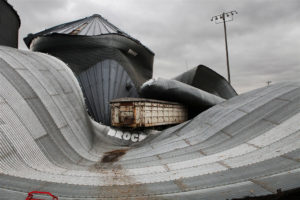
“The woodtick sucks the blood of the dog, but the germ, being so very small, goes right into the blood of the body, and there it has many children. In those days there would be as many as a billion—a crab-shell, please—as many as that crab-shell in one man’s body. We called germs micro-organisms. When a few million, or a billion, of them were in a man, in all the blood of a man, he was sick. These germs were a disease. There were many different kinds of them—more different kinds than there are grains of sand on this beach. We knew only a few of the kinds. The micro-organic world was an invisible world, a world we could not see, and we knew very little about it. Yet we did know something. There was the bacillus anthracis; there was the micrococcus; there was the Bacterium termo, and the Bacterium lactis—that’s what turns the goat milk sour even to this day, Hare-Lip; and there were Schizomycetes without end. And there were many others….”
Here the old man launched into a disquisition on germs and their natures, using words and phrases of such extraordinary length and meaninglessness, that the boys grinned at one another and looked out over the deserted ocean till they forgot the old man was babbling on.
“But the Scarlet Death, Granser,” Edwin at last suggested.
Granser recollected himself, and with a start tore himself away from the rostrum of the lecture-hall, where, to another world audience, he had been expounding the latest theory, sixty years gone, of germs and germ-diseases.
“Yes, yes, Edwin; I had forgotten. Sometimes the memory of the past is very strong upon me, and I forget that I am a dirty old man, clad in goat-skin, wandering with my savage grandsons who are goatherds in the primeval wilderness. ‘The fleeting systems lapse like foam,’ and so lapsed our glorious, colossal civilization. I am Granser, a tired old man. I belong to the tribe of Santa Rosans. I married into that tribe. My sons and daughters married into the Chauffeurs, the Sacramen-tos, and the Palo-Altos. You, Hare-Lip, are of the Chauffeurs. You, Edwin, are of the Sacramentos. And you, Hoo-Hoo, are of the Palo-Altos. Your tribe takes its name from a town that was near the seat of another great institution of learning. It was called Stanford University. Yes, I remember now. It is perfectly clear. I was telling you of the Scarlet Death. Where was I in my story?”
“You was telling about germs, the things you can’t see but which make men sick,” Edwin prompted.
“Yes, that’s where I was. A man did not notice at first when only a few of these germs got into his body. But each germ broke in half and became two germs, and they kept doing this very rapidly so that in a short time there were many millions of them in the body. Then the man was sick. He had a disease, and the disease was named after the kind of a germ that was in him. It might be measles, it might be influenza, it might be yellow fever; it might be any of thousands and thousands of kinds of diseases.
“Now this is the strange thing about these germs. There were always new ones coming to live in men’s bodies. Long and long and long ago, when there were only a few men in the world, there were few diseases. But as men increased and lived closely together in great cities and civilizations, new diseases arose, new kinds of germs entered their bodies. Thus were countless millions and billions of human beings killed. And the more thickly men packed together, the more terrible were the new diseases that came to be. Long before my time, in the middle ages, there was the Black Plague that swept across Europe. It swept across Europe many times. There was tuberculosis, that entered into men wherever they were thickly packed. A hundred years before my time there was the bubonic plague. And in Africa was the sleeping sickness. The bacteriologists fought all these sicknesses and destroyed them, just as you boys fight the wolves away from your goats, or squash the mosquitoes that light on you. The bacteriologists—”
“But, Granser, what is a what-you-call-it?” Edwin interrupted.
 “You, Edwin, are a goatherd. Your task is to watch the goats. You know a great deal about goats. A bacteriologist watches germs. That’s his task, and he knows a great deal about them. So, as I was saying, the bacteriologists fought with the germs and destroyed them—sometimes. There was leprosy, a horrible disease. A hundred years before I was born, the bacteriologists discovered the germ of leprosy. They knew all about it. They made pictures of it. I have seen those pictures. But they never found a way to kill it. But in 1984, there was the Pantoblast Plague, a disease that broke out in a country called Brazil and that killed millions of people. But the bacteriologists found it out, and found the way to kill it, so that the Pantoblast Plague went no farther. They made what they called a serum, which they put into a man’s body and which killed the pantoblast germs without killing the man. And in 1910, there was Pellagra, and also the hookworm. These were easily killed by the bacteriologists. But in 1947 there arose a new disease that had never been seen before. It got into the bodies of babies of only ten months old or less, and it made them unable to move their hands and feet, or to eat, or anything; and the bacteriologists were eleven years in discovering how to kill that particular germ and save the babies.
“You, Edwin, are a goatherd. Your task is to watch the goats. You know a great deal about goats. A bacteriologist watches germs. That’s his task, and he knows a great deal about them. So, as I was saying, the bacteriologists fought with the germs and destroyed them—sometimes. There was leprosy, a horrible disease. A hundred years before I was born, the bacteriologists discovered the germ of leprosy. They knew all about it. They made pictures of it. I have seen those pictures. But they never found a way to kill it. But in 1984, there was the Pantoblast Plague, a disease that broke out in a country called Brazil and that killed millions of people. But the bacteriologists found it out, and found the way to kill it, so that the Pantoblast Plague went no farther. They made what they called a serum, which they put into a man’s body and which killed the pantoblast germs without killing the man. And in 1910, there was Pellagra, and also the hookworm. These were easily killed by the bacteriologists. But in 1947 there arose a new disease that had never been seen before. It got into the bodies of babies of only ten months old or less, and it made them unable to move their hands and feet, or to eat, or anything; and the bacteriologists were eleven years in discovering how to kill that particular germ and save the babies.
14 commenti a “Post with tall image – Your task is to watch the goats”
Commenti chiusi





Certo Bové non è proprio il massimo della scienza, come gli studi citati sono stati confutati da ricerche successive. Ma si vede che alla Gabbanelli non interessava.
Quando EFSA da ragione a certe teorie (tipo carne clinata) va tutto bene, quando è a favore degli OGM (o altro) ecco che si grida alla parzialità. Ma siamo forse allo stadio quando si parla di sicurezza alimentare?
Sono anni che seguo report e questo è la seconda volta che punta le luci contro l’aspartame. il servizio è ben fatto (come tutti i loro servizi) e non lascia dubbi ne ombre su come in 30 anni sono state gestite le cose. OMS e INRAN si stanno giocando la loro credibilità.
Nella trasmissione e’stato detto dopo quanto tempo sorgono i segnali e quali sono gli esami da fare per vedere se ci sono stati dei danni a seguito di uso smodato e ripetuto di aspartame?
si dovrebbero mangiare dolci e bibite con moderazione perché dal punto di vista alimentare introducono eccessi di calorie e pochi valori nutritivi, non perché si assumono sostanze che possono provocare danni all’organismo perché tossiche… il principio di precauzione consiglierebbe di mettere un AVVISO sulle etichette…oppure le aziende cambino strategie..
Bè, qui si fa un’ottima sintesi: http://www.scienziatodelcibo.it/2069-aspartame-dolcificante-cancerogeno-no-forse-si-vediamo/
L’Aspartame contiene Metanolo, non so se mi spiego, quello che se usato al posto dell’alcool etilico nel vino ammazza o fa diventare ciechi. Ancora non basta? Io ne sto alla larga e dico a tutti i miei amici di evitare i dolcificanti, molto meglio zuccherare un po’ meno o usare il buon vecchio zucchero o il miele.
Quando si tratta di testare farmaci, tutti a sottolineare che gli studi sugli animali non sono rappesentativi, poi, invece, in casi come questi si accetta per vedo che i risultati sugli animali siano traslabili sull’uomo…
Sottoline che FDA ha acclamato difetti nella ricerca…
Io non capisco…ma l’aspartame provoca o meno danni all’oragnismo come tumori?E dopo quanto tempo dall’assunzione?Sono preoccupata perche’ ne ho assunto troppo fino a poco fa..
Report ha sottolineato nel suo servizio due aspetti. L’imparzialià dell’EFSA e della FDA, la cui indipendenza è messa a rischio da forti interessi delle lobby, le quali hanno molti dipendenti dell’EFSA appunto, nel loro libro paga, e l’aspetto legato a presunti difetti dello studio pubblicato dal Ramazzini. In realtà, parlo per esperienza poiché ho lavorato qualche anno con i topi nudi (senza pelo), il fatto di non sopprimerli in giovane età da maggior risalto alla ricerca, poiché permette di valutare l’effetto cancerogeno a lungo termine. Questo è il difetto imputato alla ricerca del Ramazzini. Gli altri laboratori, per abbattere i costi, sopprimono i topi in giovane età, per cui si valutano gli effetti di cancerogenesi solo a medio termine, ovvero si passa una informazione incompleta. Ma tant’è…questi sono i protocolli, per cui guiridicamente, l’EFSA è a posto, ma la realtà non è detto corrisponda a quella stabilita dai protocolli. Non resta che attendere l’ulteriore parere si settembre.
Io ho fatto la prova su me stessa, dolcificare con l’aspartame non fa assolutamente perdere peso.
Ma una cosa è certa rende tutto più cattivo!
Meglio il buon vecchio zucchero con moderazione!
Qualche decennio fa, per imporre l’aspartame " sul mercato", le multinazionali chimiche finanziarono studi tesi a dimostrare che la " saccarina" era cancerogena …….. Gli allocchi si terrorizzarono e…. l’aspartame diventò universale …..
Ora si pubblicano cosiddetti studi per dimostrare che l’aspartame è cancerogeno, perché bisogna propinare agli allocchi la ( o lo ) stevia ( il quale fra una ventina d’anni risulterà cancerogeno, perché ci sarà un nuovo dolcificante …….)
Penso che bisognerebbe togliere la patria potestà ai genitori che propinano ai figli bevande,merende e junk food dolcificati con fruttosio e dolcificanti artificiali ; per gli adulti che usano questi cibi non provo nessuna comprensione, vista la loro stupidità.
tutti gli ottimi commenti dimostrano come il senso critico che permea la rete non possa essere smontato a tavolino da sedicenti esperti o burocrati.
Ma che figura ha fatto il Ministero della Salute e l’ISS? Sono pagati con i nostri denari e dovrebbero avere a cuore la salute pubblica? Sinceramente da stare a bocca aperta…..di questi tempi soprattutto..
Chi ha detto che dobbiamo bere bibite gassate e tutti quei prodtti INDUSTRIALI presenti sugli scaffali? Fai la scelta giusta. Alimentati con ciò che aveva l’uomo primitivo e vedrai quanti acquisti nella tua dispensa SIANO INUTILI!
1
11 Ott 2012
alle 12:33
alberto
Io guarderei la puntata completa:
http://www.youtube.com/watch?v=SzTmxxf3LwY
E state attenti alle sigle:
ASPARTAME
– E951
– ACESULFAME K
– E950
– FONTE DI FENILALANINA
– SUCRALOSIO
– E955
Ora c’è la Stevia, realmente naturale ed acquistabile presso vari negozi bio o su internet sul sito http://www.leantichericettedeimonaci.it